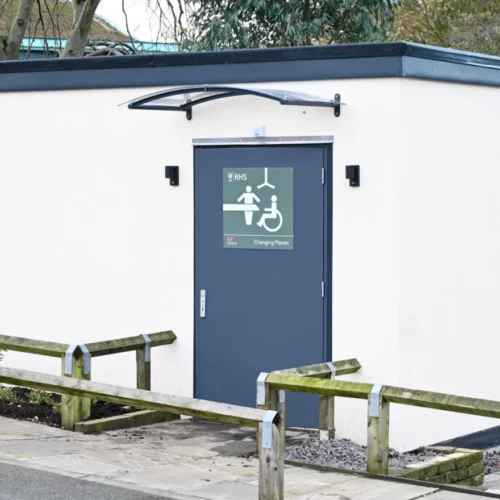Why Are Changing Places Toilets Important?
Over 250,000 people in the UK rely on Changing Places toilets. These include people with profound and multiple learning disabilities, motor neurone disease, multiple sclerosis, cerebral palsy, and other conditions that mean they need more support than a standard accessible toilet provides.
A Changing Places toilet allows individuals and their carers to use the bathroom comfortably, hygienically, and with dignity. Without these facilities, families are often forced to change loved ones on toilet floors; an undignified and unsafe practice.
Essential Features of a Changing Places Toilet
To meet national standards, a Changing Places toilet must include several key features. Below is a breakdown of what you should expect in a fully compliant facility.
1. Ceiling-Mounted Hoist System
One of the most important elements is a ceiling-mounted hoist or a mobile hoist. This allows for safe and easy transfers between a wheelchair and the toilet or changing bench. The hoist must be full-room coverage, ideally operating on a tracking system that spans the entire room.
2. Height-Adjustable Adult-Sized Changing Bench
Unlike baby changing stations, this is a full-length, adult-sized bench designed for changing adults or older children. It must be:
- At least 1800mm in length
- Height adjustable (electrically operated preferred)
- Robust, hygienic, and easy to clean
This bench ensures carers can assist without risking their own health or compromising the dignity of the person being changed.
3. Adequate Space
A compliant Changing Places toilet must be at least 12 square metres (3m x 4m) in size, with a ceiling height of at least 2.4m. This space allows:
- Room for the person using the facility
- Two carers to assist
- Free movement of a wheelchair
- Safe use of the hoist and bench
The layout must be clear and uncluttered, promoting accessibility from all sides.
4. Peninsular Toilet
A peninsular toilet (accessible from both sides) is required to allow carers to assist from either side. There should be:
- At least 1000mm of space on either side
- Drop-down grab rails and wall-mounted support rails
This arrangement is crucial for transfers and ease of access.
5. Privacy Screen or Curtain
Privacy is important for users and carers. A mobile privacy screen or curtain allows individuals to maintain dignity during changes or toileting.
6. Non-Slip Flooring and Emergency Alarm System
Flooring must be non-slip to reduce the risk of falls. An emergency alarm system (with pull cords within reach) must also be fitted, allowing users or carers to summon help if needed.
7. Accessible Sink and Hand Dryer
Sinks should be height-adjustable or positioned to be usable by people in both seated and standing positions. Hand dryers and soap dispensers must also be accessible, ideally located within easy reach from a seated height.
Meeting the Standards
To be officially recognised, a Changing Place must comply with BS8300 and Building Regulations Approved Document M. Many public venues, including shopping centres, airports, hospitals, and tourist attractions, are now required to install these facilities.
Having a Changing Places toilet is more than accessibility – it’s inclusivity. It promotes safety and respects everyone’s right to access public spaces independently and with dignity.
FAQs: Changing Places Toilets
1. What is the difference between a Changing Places toilet and a standard accessible toilet?
A Changing Places toilet includes a hoist, adult changing bench, more space, and specialised equipment, whereas a standard accessible toilet does not cater for complex needs.
2. Who uses Changing Places?
They are designed for people with profound and multiple learning disabilities, spinal injuries, muscular conditions, and other mobility impairments.
3. Is it a legal requirement to have Changing Places toilets?
As of 2021, certain new public buildings in England are required to include them under Building Regulations. Existing buildings are strongly encouraged to install them.
4. How much space is needed for a Changing Places toilet?
The minimum requirement is 12m² (3m x 4m) with a ceiling height of at least 2.4m.
5. Can anyone use a Changing Places toilet?
While they are publicly accessible, they are specifically designed for those who need specialist equipment and support.



